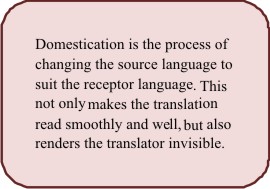| |
What is a good translation?
Venuti undertakes an interesting exercise to illustrate how the similarity to the original is the most valued attribute of a translation. He examines book reviews of translations that were published by leading newspapers and magazines, and points out how all of them invariably comment on the quality of the translation, as “pleasantly fluent”, “not quite idiomatic”,or “translation which flows crisply despite its occasionally disconcerting British accent” (3). None of them interestingly mentions the name of the translator. What constitutes a ‘good’ translation is the work rendered into language that is modern with vocabulary that is commonly used by the people. It will generally follow the syntactic pattern of the target language, make accessible the thoughts of the foreign text in language that is familiarized or to use Venuti’s term, “domesticated” (5). He is of the view that plain language, especially in the translation of non-literary works, is the end-product of market forces at work. With advancements in scientific research, clear and accurate translations from other languages became very important. The commercial interests of advertising also require clear communication with a motive to sell, of products across the world. ‘Transparent’ translations are crucial in this field. Venuti says that the trend in translation in the Anglo-American world, has been towards fluency and ease since the 18th century. This has made its impact on the literary as well as technical field. attribute of a translation. He examines book reviews of translations that were published by leading newspapers and magazines, and points out how all of them invariably comment on the quality of the translation, as “pleasantly fluent”, “not quite idiomatic”,or “translation which flows crisply despite its occasionally disconcerting British accent” (3). None of them interestingly mentions the name of the translator. What constitutes a ‘good’ translation is the work rendered into language that is modern with vocabulary that is commonly used by the people. It will generally follow the syntactic pattern of the target language, make accessible the thoughts of the foreign text in language that is familiarized or to use Venuti’s term, “domesticated” (5). He is of the view that plain language, especially in the translation of non-literary works, is the end-product of market forces at work. With advancements in scientific research, clear and accurate translations from other languages became very important. The commercial interests of advertising also require clear communication with a motive to sell, of products across the world. ‘Transparent’ translations are crucial in this field. Venuti says that the trend in translation in the Anglo-American world, has been towards fluency and ease since the 18th century. This has made its impact on the literary as well as technical field.
What is the politics behind this sort of translation? The translations, in their attempt to be fluent in the target language (which is English in the Anglo-American world), tend to downplay the distinctive qualities that might mark a work in the source language. For example, we know the distinguishing features of Tolstoy’s themes, but never the distinguishing features of his language or style. This is because the translator cannot afford to be true to the idiosyncrasies of an individual author as it would appear too foreign and become a stumbling block for the target language reader. Venuti quotes a British translator J. M. Cohen who points to another problem with this obsession about fluency. He says that translators “have generally concentrated on prose-meaning and interpretation, and neglected the imitation of form and manner”, which leads to “the risk of reducing individual authors’ styles and national tricks of speech to a plain prose uniformity” (6). This is the result of far too much domestication on the part of the translator. The domestication is sometimes so effective that the work done by the translator to domesticate it, is rendered invisible.
|